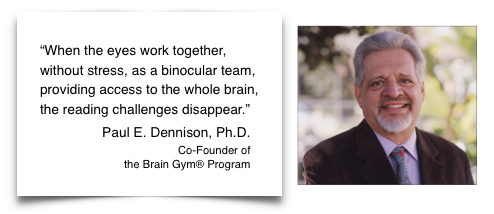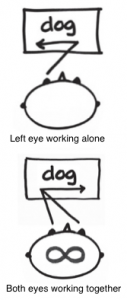Why is Brain Gym® so transformational in regard to Reading?
The Brain Gym® program is a dynamic support in regard to reading because so much of the reading process relies on efficient brain organization, especially communication between the two brain hemispheres.
Greatly simplified:
• The left hemisphere does “decoding of the symbols” of reading – that means recognizing the letters themselves, knowing what sounds they make, and combining them to create the words.
• The right brain is involved in knowing what those sounds go together to mean.
For some people, using both hemispheres together is easy and natural, perhaps because they developed the necessary patterns in early childhood from abundant physical activity. Other people may struggle, perhaps because these patterns were never fully developed. Even when all systems are in place, stress — at any age — can cause the two hemispheres to communicate less fully, and get in the way of full reading ability and comprehension.
If a child is operating without easy flow of information between his two hemispheres, he won’t be able to call on “both brains” at the same time. This means he’ll be able to do only one – or the other – of these two elements of reading. Then:
• If he’s left-brain dominant, he’ll end up approaching reading primarily with the left brain. He may be able to efficiently sound out words, but have no idea what he’s read.
• If he’s right-brain-dominant, he’ll end up approaching reading primarily with the right brain. He’ll have little access to the ability to notice differences in the symbols of the alphabet, and know which sounds they go with. In fact, the letters and words themselves may look like “mush.”

Fortunately, Brain Gym movements and processes were specifically designed
to develop eye-teaming and whole-brain integration!
Brain Gym as a means of resolving reading challenges
Once new, more efficient, patterns are in place in the nervous system, the reasons for the struggle with reading may simply vanish.
Why?
• Both brain hemispheres are now participating in the reading process, doing “phonics” and “comprehending the story” at the same time.
• Both eyes are now teaming, easily tracking left-to-right along the sentence.
• Visual disorientation caused by lack of eye teaming (think “vertigo”) is no longer upsetting the nervous system.
• Reversals disappear. For example, there is no more confusion between “b” and “d.”
Observing these changes in the child’s abilities, and with this information about where the challenges have been coming from, parents and teachers begin to understand just why the child has had such strong impulses to avoid reading.
Of course, it’s not as simple as that for every reader. But for those who fit this profile – eyes not teaming, brain hemispheres not sharing information, and, perhaps, being left-eyed as well (see the upcoming links) – the results are often nothing short of stunning. With their more straightforward challenges so easily resolved, schools and agencies then have more resources left to work with the children whose more profound challenges require different interventions.
When the reader is left-eyed
Another element at play is whether the child is right- or left-eyed.
• The right eye (on its own) prefers to track left-to-right, the same direction we read.
• The left eye (on its own) prefers to track right-to-left. This often produces reversals (reading “d” for “b,” etc.).
• Once both eyes are working together (this is called teaming), the two eyes track together perfectly. Then it doesn’t matter which eye is dominant; they track as a team wherever they need to go.
• Eye teaming requires easy communication between the two hemispheres. (Sound familiar?)
Additional complications arise if the child is left-eyed and right-handed. Conflicting directional impulses may create even greater visual confusion and spatial disorientation. The result, almost certainly, will be reversals, as mentioned above.
Left-eye dominance and learning challenges
In Kathy’s experience, about 90% of children in special-education classrooms are left-eyed. That’s curious, because only about 30% of the population is left-eyed. What’s going on here?
It’s not being left-eyed that’s the problem. It’s being left-eyed, and not having both hemispheres fully communicating with each other.
Many left-eyed people are fine readers, perhaps because they got the physical movement they needed in early childhood to develop efficient cross-lateral patterning. In fact, Paul Dennison, Ph.D. (Brain Gym co-founder) has said that the left-eyed reader may have the capacity to be a “gifted reader” and a “speed reader.”
Brain Gym movements and processes can help replicate
those “missed” early childhood movement experiences at any age
and help to develop the efficient neural patterning
required for reading to be an easy, natural, and enjoyable activity.
Is it "dyslexia" or "just reversals"?
Many children experience “reversals” as they are learning to read and write: reading “saw” for “was,” for example, or writing letters backwards. In the youngest children, this is to be expected, as they’re still developing this important ability to use “both brains” together; as they mature, and these cross-lateral patterns develop, they read and write much more easily.
The challenge arises when the child is in second grade, third grade, fourth grade, or beyond – and is still making reversals. This may seem especially mystifying to parents and teachers when the child is “typically-abled” in all other respects – curious, capable, and intelligent – and still struggles with reading.
These struggles may occur because the child never got the kind of movement experiences he needed in his earliest years, and still is struggling without full access to both brain hemispheres simultaneously. In addition, the child may be left-eye-dominant; this compounds issues, as the left eye, without teaming help from the right eye, most naturally tracks right-to-left (backwards of our printed language). See links above this one for more information about this.
In Kathy’s experience, children with this kind of history respond very quickly to Brain Gym movements and processes; often, all they need is a dynamic boost to encourage left-right hemisphere integration, and they’re off and running. Brain Gym movements, especially the “Midline Movements,” which are designed to support left-right integration, are key here. And the Brain Gym “balance” process can support quite rapid change. This story of Henry, who became a fluent reader following a single Dennison Laterality Repatterning, is just such an example.
When simple Brain Gym interventions are not sufficient, it may be that the child has deeper challenges in visual or auditory processing and the like, and require more in-depth interventions, over much more time.
Without support, both types of children may end up being labeled “dyslexic.”
The difference is that, with the right interventions, “simple reversals” may be resolved quite quickly!
Links to client stories about resolving reading issues
Kathy says, “My experience is that children who don’t have efficient cross-hemisphere brain communication, especially those who are also left-eyed, struggle to read. Once this communication is in place they often read easily. Sometimes this shift takes place in a single session. The first time that happened I was astonished (see “Henry and Reading,” below). Twenty years later, I’ve seen this countless times. And it never quite ceases to amaze me.”
Here are some articles illustrating Kathy’s work with clients who were struggling with the reading process.
Henry and Reading
“Thank you for teaching me.”
Ready for Reading
Notes:
• The transformative “Dennison Laterality Repatterning” process that Kathy frequently refers to in her articles is learned in the Brain Gym® 101 course.
• In her book, Educate Your Brain, Kathy describes basic means of determining whether a person is right- or left-eyed. That said, it really doesn’t matter. If a person as reading challenges, regardless of dominant eye, the same movements and processes will help her gain the efficient brain organization she needs to be a skilled reader.
Subscribe to Kathy Brown's email communications list
You can join one, two, or all three of Kathy’s email groups, for updates on:
• her Courses schedule • new Blog postings • her Book projects
like the upcoming Educate Your Brain for Reading
© Copyright Kathy Brown 2023. All rights reserved.
All photographs other than instructor portrait images ©Copyright Laird Brown Photography. All rights reserved.
Brain Gym® is a registered trademark of Brain Gym® International, Ventura CA
Please visit the Brain Gym® website at www.braingym.org.
